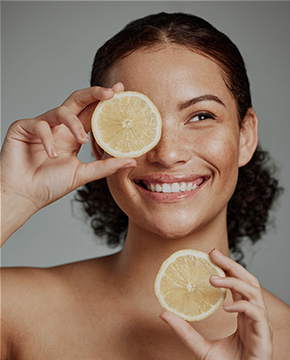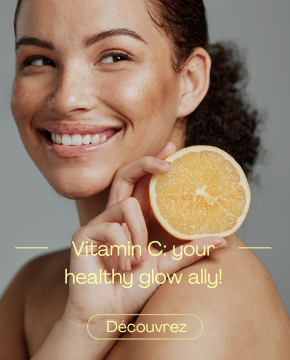Vitamin C in Cosmetics: Benefits, Precautions and Use
A few explanations
Vitamin C, also known as ascorbic acid, is a leading ingredient in the cosmetics industry. Known for its powerful antioxidant properties, it is commonly used in skincare for its many benefits. This article explores the benefits of vitamin C in cosmetics, the precautions to take and other interesting aspects of its use.
Benefits of Vitamin C for the skin
- Powerful antioxidant: Vitamin C protects the skin against damage caused by free radicals, which are unstable molecules that can cause cell damage and accelerate skin aging. By neutralizing these free radicals, vitamin C helps keep skin young and healthy.
- Stimulation of Collagen Production: Vitamin C plays a crucial role in the synthesis of collagen, an essential protein that gives skin its structure and firmness. Increased collagen production can reduce the appearance of fine lines and wrinkles, contributing to smoother, firmer skin.
- Lightening the complexion: Vitamin C helps to lighten the complexion by inhibiting the production of melanin, the pigment responsible for brown spots and hyperpigmentation. It can also reduce acne scars and sunspots, leaving skin more even and radiant.
- Hydration and Skin Barrier Protection: By improving the skin barrier, vitamin C helps retain moisture, preventing dryness and dehydration. It can also protect the skin against external aggressors such as pollution and UV rays.


Optimal use of Vitamin C
- Morning application: For optimum effectiveness, we recommend applying your Vitamin C skin care product in the morning to maximize its antioxidant protection against environmental aggressors.
- Combining with sunscreen: It's important to combine your Vitamin C treatment with SPF50 sunscreen (ideally) for optimum UV protection.
- Skincare routine: We suggest that you incorporate vitamin C skincare into your daily skincare routine. You can start with a care product with a low concentration of Vitamin C, such as Vital C Cream - Ref.714, then integrate Vital C Serum - Ref.713 to be applied with your cream. For more effective results, opt for our highly concentrated serum with over 15% Vitamin C, N°99 Concentré antioxydant Vit C15 - Ref.599.
Precautions to take with vitamin C skincare
- Sensitivity and irritation: Vitamin C can sometimes cause irritation, particularly in people with sensitive skin. It is advisable to start with a low concentration and gradually increase according to the skin's tolerance. It is possible to assess tolerance to a product (or ingredient) by testing it on the inside of the elbow, where the skin is thinner.
- Protection from light and air: Vitamin C is highly sensitive to light and air, which can make it unstable and reduce its effectiveness. We recommend choosing products packaged in opaque, airtight bottles. It is also important to store your products away from heat and light to preserve their effectiveness.
- Incompatibilities with other ingredients: Certain ingredients may reduce the effectiveness of vitamin C or cause irritation when combined. For example, vitamin C may be unstable in the presence of retinol or niacinamide. It's best to use these ingredients at different times of the day, or to alternate them.
The different chemical forms of vitamin C in cosmetics
In cosmetics, vitamin C is used in a variety of chemical forms to maximize its efficacy, stability and skin tolerance. Here are the main forms of vitamin C found in skin care products:
- Ascorbic Acid (L-Ascorbic Acid): Ascorbic acid, or pure vitamin C, is the most commonly used and studied form. It is highly effective, but also unstable and sensitive to light, air and water. It is often formulated in concentrations ranging from 5% to 20%. Ascorbic acid is ideal for stimulating collagen production, brightening the complexion and providing antioxidant properties.
- Ascorbyl Palmitate: Ascorbyl palmitate is a fat-soluble vitamin C derivative. It is more stable than ascorbic acid and is often used in moisturizers and sunscreens. Although less potent than ascorbic acid, it is also less irritating and offers good skin tolerance.
- Magnesium Ascorbyl Phosphate (Magnesium Ascorbyl Phosphate - MAP): MAP is a water-soluble vitamin C derivative. It is highly stable and well tolerated by the skin, even at high concentrations. MAP is particularly effective in brightening the complexion and providing antioxidant protection.
- Sodium Ascorbyl Phosphate (Sodium Ascorbyl Phosphate - SAP): SAP is another water-soluble vitamin C derivative, known for its stability and gentleness. It is effective against acne and offers lightening and antioxidant properties similar to those of MAP.
- Tetrahydroxydecyl Ascorbate (THDA): THDA is a fat-soluble derivative of vitamin C, extremely stable and well tolerated. It penetrates easily into the skin and is effective at low concentrations. THDA is used for its anti-aging and brightening effects.
- Ascorbyl Glucoside: Ascorbyl glucoside is a water-soluble derivative of vitamin C, stabilized with glucose. It is known for its stability and effectiveness in brightening skin and reducing the signs of aging.
- Ethyl Ascorbic Acid: Ethyl ascorbic acid is a stable vitamin C derivative with good skin penetration. It is efficient for brightening the complexion, stimulating collagen production and providing antioxidant protection.
- 3-O-Ethyl Ascorbic Acid: This is an etherified form of ascorbic acid, offering greater stability and skin penetration. It is known for its lightening and antioxidant properties. Each form of vitamin C has its own advantages and disadvantages, in terms of stability, skin tolerance and efficacy. The choice of vitamin C form depends on skin type, specific concerns and the overall formulation of the cosmetic product. Using these varied forms, skincare products can offer a range of benefits from complexion brightening to antioxidant protection and stimulation of collagen production.



Our challenges in manufacturing efficient products with highly concentrated Vitamin C
Manufacturing a cosmetic product with a high concentration of vitamin C presents a number of challenges due to the intrinsic properties of vitamin C. Here are the main difficulties encountered:
- Vitamin C instability: One of the biggest challenges is the instability of vitamin C (ascorbic acid), which degrades easily when exposed to air, light and water. This can significantly reduce the efficacy of the final product.
- Oxidation: Vitamin C rapidly oxidizes in the presence of oxygen, which not only reduces its efficacy but can also lead to a brown or yellowish discoloration of the product, affecting its appearance and consumer acceptability.
- Formula and pH: Ascorbic acid is most effective at a low pH (below 3.5), but too low a pH can irritate the skin, especially at high concentrations. Finding a balance between efficacy and skin tolerance is a major challenge for our formulators.
- Compatibility with other ingredients: Vitamin C can be incompatible with certain ingredients commonly used in skin care, such as retinol, AHAs (alpha-hydroxy acids) and certain preservatives. This may limit formulation options and require rigorous testing to ensure the stability and efficacy of the final product.
- Release technology: To improve the stability and efficacy of vitamin C, some formulations use controlled-release technologies or encapsulations. However, these technologies can increase production costs and the complexity of the manufacturing process.
- Preservation and packaging: To protect vitamin C from oxidation, it is essential to use hermetically sealed, opaque packaging. Airless packaging and amber or opaque glass bottles are often necessary, which can also increase production costs.
- Stability assessment: Stability testing is crucial to ensure that the product maintains its effectiveness throughout its lifetime. These tests must simulate real-life conditions of use and storage, adding time and cost to product development.
- Efficacy and safety: At high concentrations, vitamin C can cause skin irritation, especially in people with sensitive skin. Clinical trials are required to assess tolerance and efficacy, adding another layer of complexity and cost to product development.
Solutions and Innovations
- Use of Stable Vitamin C Derivatives: Our formulators use derivatives such as magnesium ascorbyl phosphate (MAP), ascorbyl glucoside and ethyl ascorbic acid, which are more stable than pure ascorbic acid and offer good skin tolerance.
- Microencapsulation technologies: Microencapsulation protects vitamin C from oxidation and enables controlled release, increasing product stability and efficacy.
- Innovative packaging: Airless packaging and amber or opaque glass bottles reduce exposure to air and light, preserving product stability.
- pH-adjusted formulations: Adjusting pH to balance efficacy and skin tolerance is essential. This often involves the use of buffers and stabilizing agents.
Manufacturing cosmetics with high concentrations of vitamin C is a complex process, requiring formulation expertise, advanced technologies and rigorous testing. By overcoming these challenges, manufacturers can create effective, stable products that deliver the many benefits of vitamin C for the skin.
Conclusion
Vitamin C is a versatile and powerful cosmetic ingredient that offers numerous benefits for the skin. However, to get the most out of it, it's important to use it correctly and take precautions to avoid irritation and incompatibility with other products. By choosing the right formulations and incorporating vitamin C into a balanced skincare routine, you can achieve brighter, firmer, younger-looking skin.
Please do not hesitate to contact us if you would like further information or product advice tailored to your needs.






